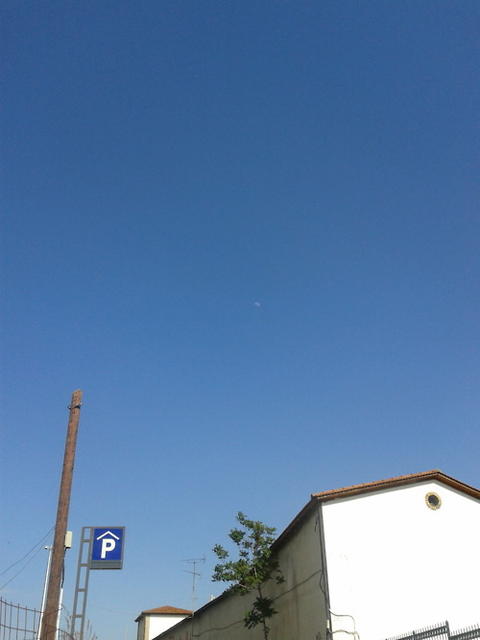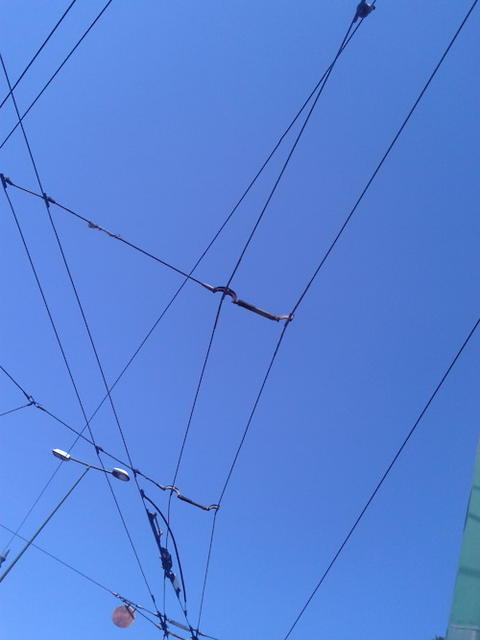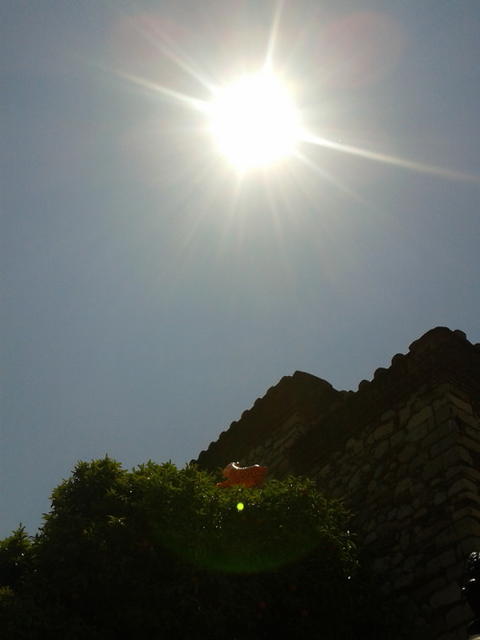The first night is for flopping, exhausted, into whatever hostel, hotel, or friend-of-a-friend’s apartment I have booked, borrowed or blagged. And then for getting up again, for walking the streets of the neighbourhood until the moon shows above the bay/bridge/ruin/whatever, compulsively needing to find out exactly where I am on the map.
It’s 11 a.m. I arrived late yesterday evening, rendered passive by timetables, by regulations, by the arbitrary constraints of the railway grid – often of the most absurd kind – switching, for no reason, from country to country. I welcome them. Because I know I am travelling away from meaning. In England both language and territory are native; I speak French and know Paris well; I’ve been to Rome a couple of times and can do restaurant Italian. In Athens, in Sofia, which I have never visited before, they don’t even have the same alphabet. Street signs start off OK and then the letters crunch into triangles, polygons. Meaning crumples. I can’t keep their shapes in my head long enough to fasten them to what I see when I glance down at my map.
Across Europe, coffee is the common currency. And if I don’t speak the language, there are machines for that: ticket dispensers, ATMs, money itself. Brandish a euro and point. Use words common in every language: taxi, hotel, wifi. Buy a little book with photos instead of phrases. Prepare well enough and I’ll never have to speak to another human being.
I flip open my computer. I show the waiter my screen. The cursor flickers in the box. He understands. He types in the code.

And I am connected.
I open my email. There is a moment – awful, wonderful – while the page loads: microseconds spent waiting. However quick, it’s never quick enough.
Is there anybody there?
There is.
You are here. Or I am. Or, more rarely, we are here, together.
I am not at this cafe table, not in this street, not in Athens or Sofia or Budapest or Belgrade.
This is where I am.
Where?
I’m in the place we all live now – that overcrowded tenement where each one of us knows a little of the other’s business – in Cyberspace, which is an old-fashioned word for the Net, which has evaporated into the Cloud. I don’t know how big the Space is, how far the Net extends. I can’t see through the Cloud to its edges. I don’t know whether it works like a 2D net, or a 3D space. A digital artist friend told me the Internet really is a space manufactured in sheds on the M25, a cloud containing so many wikifacts, so many pictures of celebrities, of friends reunited, of kittens in hats, as to become a cloud of unknowing like the clouds we already know made of water particles that cloud the vision, or the kind of cloud you get on your blog that tells you what you’ve been writing about recently: a cloud made of words.

A girl, maybe eight years old, comes right up to my second tier cafe table, selected in order to avoid vendors and touts. She’s with a couple of other children, older and younger, but she’s the one who enjoys her job. Elbows on the table, she looks up into the drinkers’ eyes before she offers her hand for coins. She leans over my new MacBook Air. She puts out a finger and strokes its aluminium shell, tentatively, sensually. She has never seen anything like it before.
The word Cyberspace was invented by sci-fi writer William Gibson, a throwaway line in short story published as far back in time as 1982. He also said, ‘The future is already here — it’s just not very evenly distributed.’ Am I asking the wrong question? Maybe it’s not ‘Where am I’ but ‘When am I?’ That’s what the Internet seems to do with time and space. It makes one look like the other. Time becomes spatial, visual – a timeline, a spreadsheet; its tense, the continuous present. The future, the past, are all part of the same map and it’s as easy to click on yesterday’s news as today’s. Algorithms – everything on the Net depends on them – knock the decision-making process flat, hammer it out onto a 2D screen. Seeing the whole thing at a glance it looks like you could go sideways instead of straight on. It even looks like you could go back.
When I crossed the international border last night, time flipped another hour on from England. You wrote to me in the evening: I was already asleep. I replied in the morning before you were awake. I remember living in Bratislava in the real past, pre-internet, just-post-Soviet. How I stalked my building’s postboxes for a former love’s letters and learnt to pry them out with a pencil. I didn’t have a key – the box was my host’s – but I couldn’t wait. The drip-feed of emails is more satisfying but more addictive, like the dark syrupy coffee, like the unaccustomed sun. It is delicious to go to sleep knowing that in the morning they will be there – but is this the extinction of loneliness? I thought I was here to get away but here you are, still in my inbox. I can reread our messages in any order I please: choose your own adventure. And you can still get in touch with me any time you feel like it.
Touch. . . feel. I bury my cheek in my palm, just to be in touch with someone.
Back on my screen, you’re sending me images – ASCII art, Instagram ‘Polaroids’, e-book covers based on the design of 1960s pulp paperbacks. A picture’s worth a thousand words? These kind of pics are passed round the Net like cigarette cards, photos of things that never made it into the future, their heads stuck in time’s railings subject to taunts and kicks. Think and you’ll recognize them, as would any classroom bully. Sci-fi author Bruce Sterling (how much of the Net is defined not by technologists, but storytellers!) calls this particular marriage of retro and high technology, ‘atemporality’. I play the game. I send you a clip of Buckminster Fuller’s proto-car, a smooth-parking manatee of a machine: a possible future that never went into production. I re-shot the grainy 1930s black-and-white filmstock on my crystal-clear smartphone last week at a Paris museum. Atemporal enough? An exchange of gifts is traditional in courtship. Each image, as it crosses the microvoid between us, a virtual bunch of flowers.
Why do we need all this old stuff? Is it because the new stuff’s scary? In supermarkets the last barcoded apples nudge each other to remind the forklifts to restock. Though I’ve never seen it done, I’ve heard your fridge can do your shopping, that your car can book itself in for a service. It’s always happening in Korea, in Japan. It’s always happening somewhere, somewhen else. Even here the Web can net me anything I like. I can ask for shopping, sex, love and it will appear In Real Life a few days later – through the post, as a printout from a 3D printer, on a high stool in a singles bar. There’s still a wait, the microvoid, so small sometimes as to be unnoticed. Mind the gap: I think the gap’s what bothers me. The Net has an uneasy relationship with the real, as uneasy as a word with an object.

I close my computer, pay, get up from the table. I’ve done my morning stuff: coffee, communication, posting clips and photographs on my Tumblr. Now it’s time to walk.
How do I decide how to walk this city In Real Life, where crossing real space takes real time? What’s my algorithm, my decision-making process? If I could feed my movements into a programme, would it tell me what I think I’m doing here, what I’m going to do next? At every crossroads I turn because of a tree or the way light slants across a building or because of a telegraph pole against the unfamiliar deep blue of the cloudless sky. The algorithms work out differently every day. Sometimes enough similarities occur to begin to be predictive: I avoid monuments, museums, the already coded, but I make no demands. Sometimes I limit my walking to a few streets, sometimes I take it further. It depends on how much energy I have left after travel. It depends what the city’s systems want of me.
This city is a dog’s bark from far off. Workmen use picks to dig up the streets: modern tarmac vs. ancient tools. It’s not a fair fight. Churches are covered with coloured plastic weave, awaiting restoration: no builders on site. It is the same material as the large rectangular checked bags sold on the street stalls in every square here, the bags that say displaced, or homeless, or refugee.
T-shirts are some of the only things I can read. A city-break tourist strolls hand-in-hand with his girlfriend. Across her chest: ‘Wherever you are.’ On his: ‘Leave me alone.’ A man (a native of the city?) walks along the street from the station wearing a pink polo shirt – ‘Woman Love Orgasm’ – and carrying a single rose.
‘The form of the city changes faster than the human heart,’ said Baudelaire in Le Cygne, his poem for Victor Hugo. But that was Haussmann’s Paris: new buildings flung up every day, the medieval city erased, written over. That’s not how we build any more: we repurpose, cafes are for working at, factories for living in, industry’s outsourced to the ring road of someone else’s city. We live and work virtually. The form of the city evaporates into the Cloud. Is this why I’m here, to try to trace what changed, what changes? I think I am trying to trace the form of something. Could I discover, by walking these streets, how better to walk in the city of words?
My Real Life city map is in my pocket. It names the main streets: others are left blank. It misses off some of the smaller streets altogether. In each city I visit I pick up a tourist map at the station, from the lobby of my hostel. It shows me the city it thinks I’d like to see, I try not to rely on it too much. In Internet city, some streets are public (forums), others private (email), and some are in-between places where we meet but where we are also on show (Facebook, Twitter) like a cafe terrace, like the street. I keep thinking I’ll see you round the next corner. Like a city-break gone wrong I might come across you flirting with a stranger, or drunk in a strip club, or praying with a sect. How will I find you? By following your Internet footprint, by searching for words, yours or someone else’s, by typing your name, though it is such a usual name that I have already found it attached to several other people, who have all, somehow, become tangential to my idea of you.
More algorithms: space x time. In each city I visit I spend an evening arriving, a day mapping, a morning leaving, or preparing to leave. If I have an extra day inserted between the second and the fourth, the morning of departure, I begin to link up separate sites of the city, walking between them instead of taking the bus, the metro. Today, I’m leaving. I can’t stray far from my hotel. I walk to the station, twitchy for departure; unable to concentrate on the city I am in, already looking for the next.
At the grand central station I buy a coffee. I sense the triangular milling of the people in the non-space between the drinks stand, newsagent and ticket office: environmentally-dictated repetitive action, patten recognition. I am at home.
A cover band plays flamenco versions of Sinatra songs over the speakers. The fake (or real?) black marble floors are gleaming, as are the transparent salad containers, stacked on black formica behind spotless plastic visors.
I shouldn’t be this happy.
You have emailed to say you will meet me again ‘IRL’ at the end of my journey.
Sitting at the station I am entirely present yet entirely absent. Love, like hope, slips continually from the present tense. I live (I love?) mostly in the clumsy ‘future perfect’, where love exists, or when it will have existed.
The future perfect is also the tense of train travel: ‘En cinq minutes ce train sera arrivé à la Gare du Nord’. As though saying it could guarantee against delays, accidents…
Georges Perec wrote that words – after all only the arrangement of marks on a 2D page – give the ‘illusion of movement’ a bit like the way that, looking out of a train window, the landscape appears to move and the traveller feels still. Conventionally we read from beginning to end and, unless we’re the type to skip ahead, to flick, to guess the weight of story to come, a tale will reveal its ending only in its own good time. Reading is time travel both in a straight line (the time it takes to read a story) and in unexpected directions (the timezones the story covers, which may be minutes or many years). We read to stitch up gaps in time, to pass the time as we wait, or as we travel.
Skipping to the end, really the end, of this story: It didn’t work of course, not IRL, not in the present tense.
In the future perfect, which is now the past, some weeks after that morning at the cafe, I will have returned. We will have met at a station. We will have drunk a couple of strong afternoon cocktails at a nearby bar for Dutch courage then I will have put my hand in yours and you will have leant toward me and kissed me and then you (we) will have stopped and, you will have said ‘Welcome to England.’
And that will have been a great moment.
But then, after a very short time, you won’t have wanted any more.
The moment will have spun away like trees seen turning from a speeding train: it will have seemed that they were moving, but it will have been us. And you can’t stop a train like you can stop a car. A passenger, passive, there was nothing I could do to go back.
The moment became an object. I wrapped it up and put it away. I put some more time and space between me and it.
The moment shrank until I was able to write about it. Or perhaps that was part of the shrinking.
Writing is a mechanism, not for remembering, but for forgetting.

Afterwards someone told me about Jill Price, who suffers from hyperthymesia, a disease of the Internet age, ‘discovered’ in 2006. Due to an overactive ‘autobiographical memory’, she is able to recall ‘every detail’ of her life from age fourteen. I googled her 2009 interview in Wired magazine with Gary Marcus, a cognitive psychologist at New York University, and found that what Price remembers hinges on the already mapped, is tied to headlines and milestones: what happened on the day of the Princess Grace’s death, or the first time she visited a carwash. Her personal narrative is calibrated to culturally shared events, events you could Tweet about. If these are autobiographical memories, they are symptomatic of where we’re at. Her unusual recall, Marcus discovers, is not only compulsive: it is cultivated. She obsessively records her life. Her diary, some of which is reproduced in Wired, looks like a thorn hedge. Writing in the present tense, using almost no punctuation, what Price lacks is borders. As do we all now I guess. On Twitter, on Facebook, we archive the present, constantly generating our own instant souvenirs.
Writing nets experience, but subjectivity’s smaller fish still slip through its holes, and something about it tends to reflection, regret: to write hopefully is no more than politics.
‘It’s better to write to a writer,’ you told me, ‘than to live with one.’ It’s better that a word remains a word, that it never reaches a destination off the screen, or the page. It’s better to travel than to arrive. But I didn’t want to leave so soon, didn’t want – having crossed the border from words to experience – to cross back to words again. I didn’t want to lose the sharpness, the strangeness, of unmapped emotion, to leave a city so quickly after arriving, with nothing more to remember it by than a trite commemorative key tag. I didn’t want to look back from my train to see the rails converge as if at some point in space, in time, they had been one indivisible line. But the choice was either to write it down or to forget it, to lose it altogether.
Maybe what I suffered from was a kind of face blindness, an inability to map the pattern set in jawbones, hairline, eyebrows. Perhaps all I knew of you was cutups, info-bytes, as short as paragraphs, as Tweets, as atomized as individual words. I could read each component but I’m not sure I was ever able to put them together into the semblance of a human being.
But I recognized your turn of phrase, like someone turning to walk away down an opposite platform. And I can see the space between your collar and your hair, a glance of the corner of your jaw, so well, more clearly than your composite features, which I have encountered so infrequently, although I have seen them reproduced in so many Facebook photos.
In-text images by Joanna Walsh







